Craving a harmonious dining room? Discover how Feng Shui can guide your color choice and create the perfect balance in your dining space.

Best Color for Dining Room Feng Shui
By coincidence, you're considering repainting your dining room just as we're discussing Feng Shui colors. It's important to understand that the color you choose can significantly influence the energy of this space.
Will you opt for warm, inviting hues or cool, calming shades? Perhaps you'll consider a balance of both.
But how does one decide which is the best color for a dining room according to Feng Shui principles? The answer might not be as straightforward as you think, but it's certainly worth exploring further.
Key Takeaways
- Warm colors like earthy browns, reds, and sunny yellows are ideal for dining rooms as they promote happiness and stimulate appetite.
- Blues and greens can also be used in dining rooms to encourage a sense of calmness and relaxation.
- Balancing yin and yang with the effective interplay of different colors is pivotal in achieving a harmonious dining room Feng Shui.
- Avoid overuse of any color, particularly fiery reds and blacks, to prevent igniting tension or draining energy, maintain balance and moderation.
Understanding Feng Shui Basics
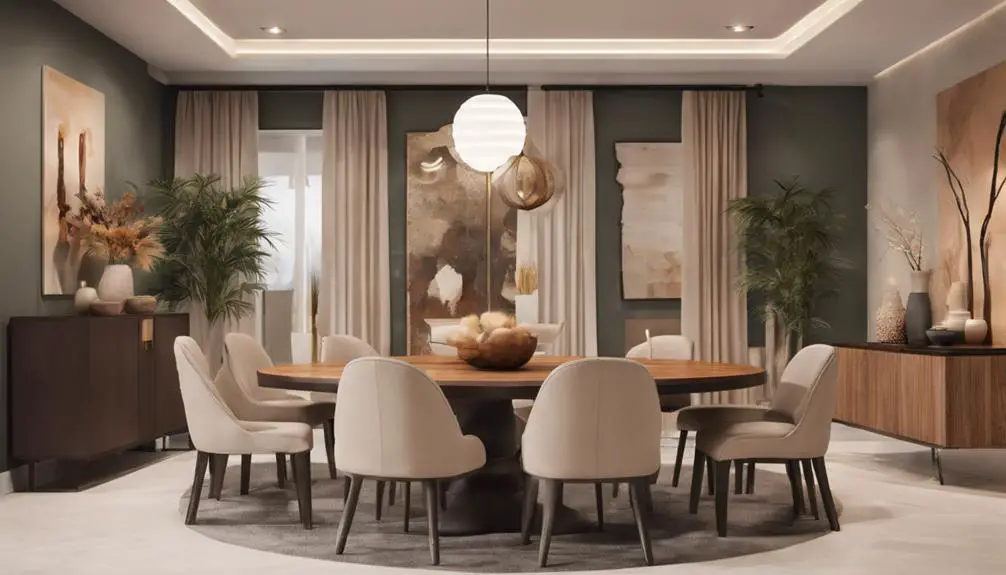
Before you dive into selecting the perfect color for your dining room, let's first unravel the basic principles of Feng Shui, an ancient Chinese art that harmonizes energy within a space. Tracing back over 3,000 years, the Feng Shui history is a waltz of wisdom and mystery. It's a dance of elements, numbers, and directions, all choreographed to balance the energies of your surroundings.
Initially, Feng Shui was used to locate auspicious sites for buildings and graves, but as time unfurled, it began to shape the interior of homes, guiding the placement of furniture and color selection for the enhancement of life's quality. It's not just about aesthetics; it's about orchestrating a symphony of energy flow principles.
Imagine your space as a living entity, it breathes in Qi, the life force, and exhales it, creating a rhythm, a pulse. This Qi should flow smoothly, like a gentle river, and not rush like a tumultuous waterfall. Obstacles, clutter, or poorly placed objects can disrupt this flow, creating disharmony. Understanding these principles of Feng Shui, you're now ready to choose a color that sings in harmony with your dining room's Qi.
Importance of Color in Feng Shui
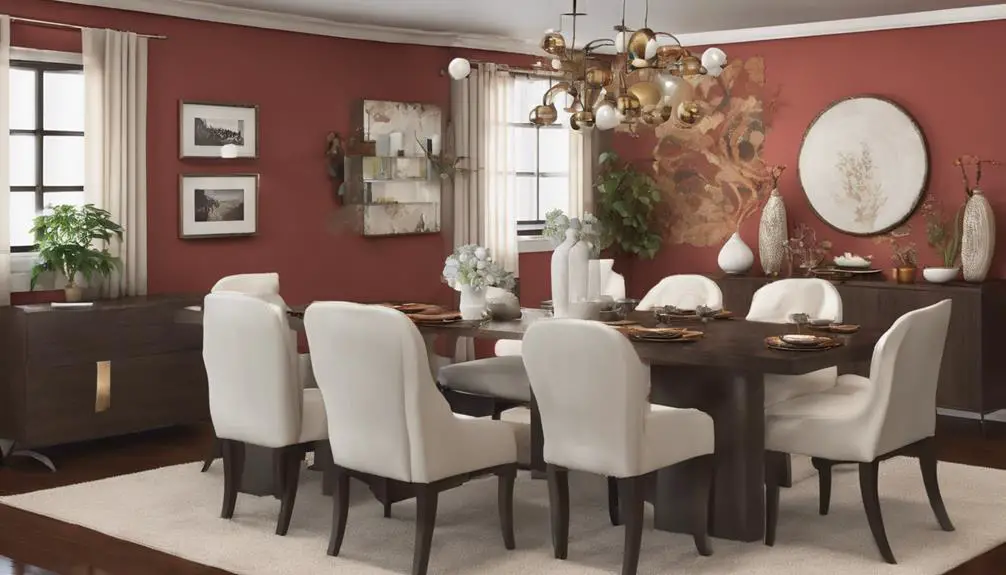
Delving into the essence of Feng Shui, you'll discover that color isn't merely a decorative aspect; it's a vibrant character in the narrative of energy flow, playing a pivotal role in balancing, enhancing, and directing your space's Qi. It's a language that communicates with your subconscious, shaping and maneuvering the energy of your dining room.
To understand color symbolism in Feng Shui, it's crucial to realize that each hue represents a unique energy type. Color choice, therefore, can have a profound impact on mood and overall energy balance.
| Color | Symbolism in Feng Shui |
|---|---|
| Red | Passion, Fame, Riches |
| Green | Growth, Health, Vitality |
| Blue | Calmness, Wisdom, Healing |
Red, for instance, symbolizes fame and riches, and can stir up excitement or urgency. Green, on the other hand, represents growth and vitality, fostering a rejuvenating and calming ambiance. Blue, associated with wisdom and healing, promotes tranquility and intellectual engagement.
Choosing colors wisely can create harmony, evoke emotions, and enhance the energy in your dining room. In the world of Feng Shui, color is more than a mere decoration; it's a powerful tool for shaping your space's Qi.
Best Feng Shui Colors for Dining Rooms

Having explored the potent symbolism of colors in Feng Shui, let's now illuminate the ideal hues for your dining room, a space where nourishment and conviviality intertwine. The dining room, more than any other space, thrives on a balance of warmth, welcome, and tranquility. The colors you choose have a powerful impact on achieving this balance and enhancing dining harmony.
Warm shades like earthy browns and sunny yellows tap into the energy of the earth and sun, fostering a sense of grounding and joy. They're perfect for promoting lively conversation and hearty laughter. Reds, with their inherent fire element, stir up appetite and passion, whereas blues and greens, reminiscent of water and nature, foster calmness and relaxation.
However, color psychology impact isn't a one-size-fits-all concept. While certain colors might stimulate appetite in some, they might trigger unease in others. Therefore, consider the personalities and preferences of those who'll be using the room the most.
Incorporating Feng Shui Colors Effectively
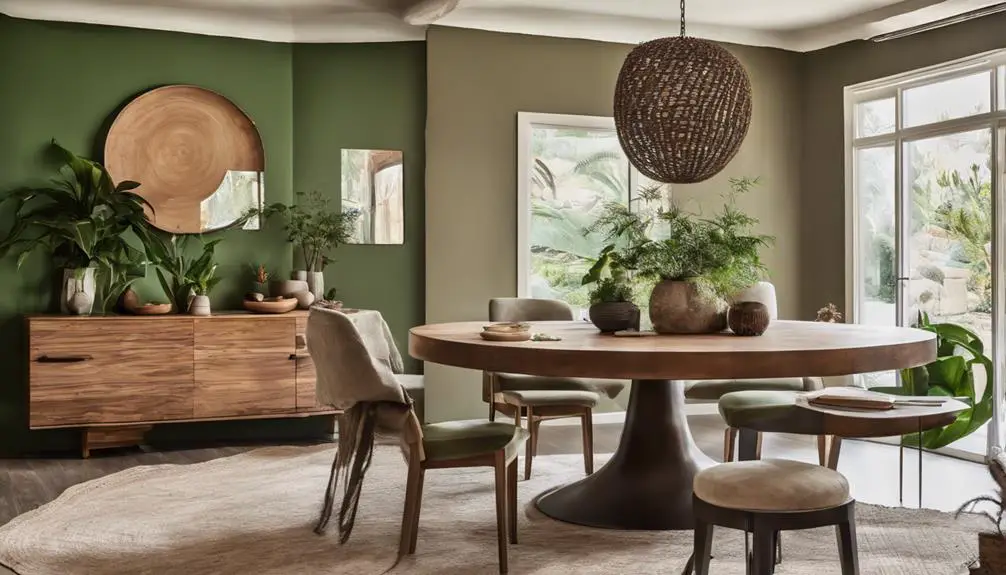
Now, as you step into the art of incorporating Feng Shui colors effectively, it's crucial to remember that it's not just about splashing your walls with a fresh coat of paint. It's about creating a harmonious environment that resonates with your energy, and that begins with understanding color symbolism in Feng Shui.
Each color embodies a certain type of Chi (energy), and its impact extends beyond the surface. It seeps into the very fabric of your living space, influencing your mood and energy levels. Red, for instance, symbolizes passion and vitality, while green reflects growth and renewal. Hence, thoughtful use of colors can create an atmosphere that uplifts and soothes at the same time.
Balancing yin and yang with colors is also a pivotal aspect of Feng Shui. Yin colors like blue and black can cool down a room with too much fiery energy, while Yang colors such as red and orange can inject life into a dull, stagnant space. It's this delicate dance of colors, their symbolism, and their harmonious interplay that truly embodies effective Feng Shui.
Avoid These Feng Shui Color Mistakes
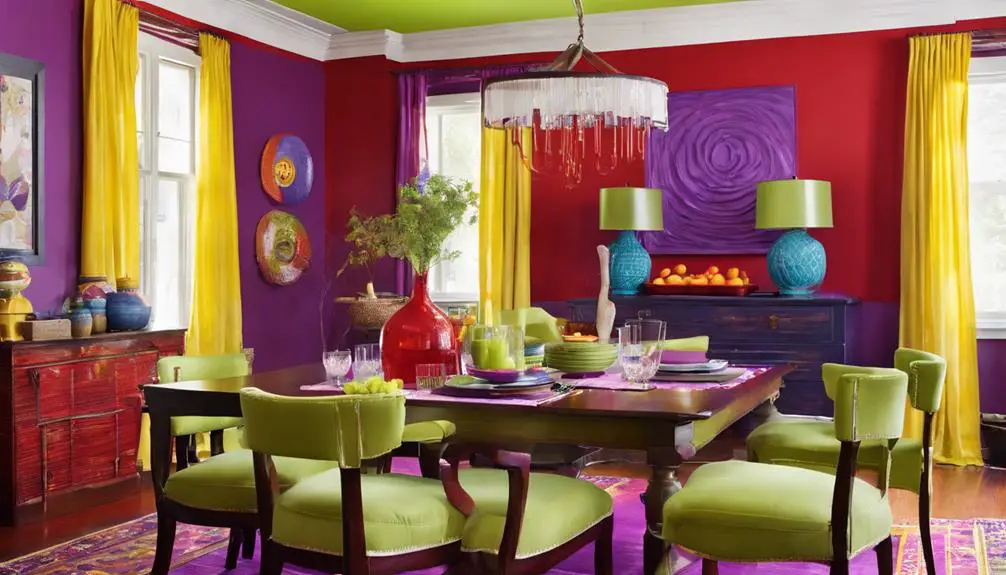
As you venture into the realm of Feng Shui, it's essential to sidestep common color mistakes that could disrupt your home's harmonious energy flow. Mistake identification is your first step towards a peaceful dining room experience. An overuse of fiery reds, for instance, could ignite tension instead of fostering a relaxed, appetizing environment. Similarly, excessive black might drain energy, turning your space into a vortex of lethargy.
Your color correction journey begins with striking a balance. Remember, all shades have a place in Feng Shui, but moderation is key. The trick lies in the blend. For instance, if you've fallen into the abyss of too much black, introduce elements of earthy browns or nourishing greens to reestablish equilibrium.
Next, be aware of conflicting colors. Mixing opposite tones like red and blue can create a visual clash that disturbs the room's tranquillity. Instead, lean towards harmonious color pairs, like green and soft yellow, that reflect nature's effortless symbiosis.
Lastly, avoid using colors you detest. Your personal connection to the chosen hues is crucial in Feng Shui. If a particular color invokes negative feelings, it's likely to affect the room's energy negatively. After all, your dining room should be a personal sanctuary, not just a Feng Shui showroom.
Real-life Dining Room Feng Shui Transformations
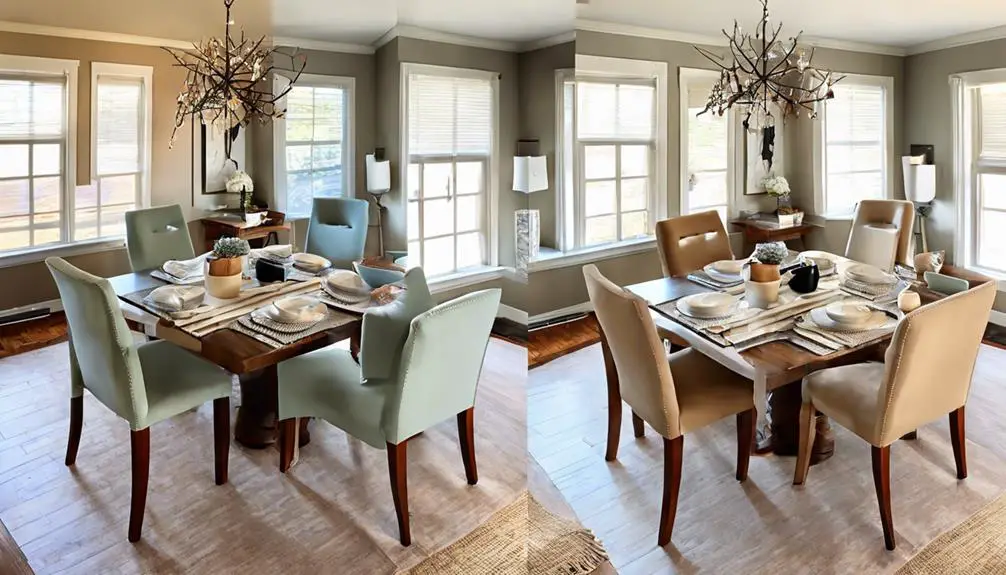
Let's dive into the transformative power of Feng Shui by exploring how real-life dining rooms have been reborn through thoughtful color choices. You know, it's not just about hues; Dining Room Layouts and Table Shape Significance also come into play.
Imagine a room bathed in a serene sea-green, the color seamlessly flowing with an oval table, symbolizing unity and eternal success. In another scenario, visualize a dining room bathed in warm earth tones, a square table at its heart, grounding the energy and fostering stability.
| Before Transformation | After Transformation |
|---|---|
| Dull, monochrome palette | Vibrant, sea-green hues |
| Cluttered, uninviting layout | Harmonious, inviting dining room layout |
| Rectangular, imposing table | Oval, unifying table |
| Cold, uninviting atmosphere | Warm earth tones, square table |
These transformations are not just about aesthetics; they're about creating a space that nourishes the soul, fosters harmony, and manifests prosperity. So, don't underestimate the power of color in your dining room. It's your canvas to express and create the energy you desire. With Feng Shui, you're not just decorating; you're orchestrating a symphony of colors, shapes, and layouts that sing in harmony.
Frequently Asked Questions
What Are Some General Rules for Combining Different Feng Shui Colors in a Dining Room?"
When blending different feng shui colors in your dining room, it's crucial that you maintain balance. Yin and Yang should harmonize, neither overpowering the other. Incorporating metallic colors can add an elegant touch, but don't overdo it.
Use softer colors to counteract the strong energy of metallics. Remember, it's about creating a calm, inviting space where energy can flow freely. Trust your instincts and don't be afraid to experiment until you find the perfect balance.
Does the Size of the Dining Room Affect the Choice of Feng Shui Color?"
Yes, the size of your dining room does impact your color choice. Larger spaces can handle darker, richer hues while smaller rooms need lighter colors to feel spacious.
Remember, dining room proportions aren't the only factor. The impact of lighting also plays a big part. Natural light can make a color seem brighter, while artificial light can change the color's tone.
How Do I Adjust My Feng Shui Colors for Different Seasons or Occasions?"
Adjusting your Feng Shui colors for different seasons or occasions isn't as daunting as you might think. Seasonal décor adjustments can be simple, like adding accent pieces in colors that reflect the season.
For occasion specific color changes, consider the mood you're aiming to create. Remember, it's about balance and energy flow. Be innovative, play with colors and textures. You'll be surprised how a few changes can transform your space.
Can Feng Shui Colors Influence the Eating Habits or Appetite of the People Using the Dining Room?"
Absolutely, colors can influence your eating habits and appetite. In color psychology, certain hues stimulate appetite, while others suppress it. Warm colors like red and orange encourage eating, while blues and purples often curb it.
Feng Shui symbolism also plays a part. For instance, green promotes digestion. Therefore, the color you choose for your dining room can indeed shape your eating habits, according to both color psychology and Feng Shui.
Are There Any Specific Feng Shui Colors or Combinations to Avoid for People With Certain Health Conditions or Allergies?"
In Feng Shui, color psychology can greatly impact your well-being. If you're dealing with health issues or allergies, it's best to avoid certain shades. Allergy triggering shades, such as bright, stimulating colors like red, may exacerbate conditions.
Soft, soothing colors like green or blue might be more suitable for you. Remember, it's not just about aesthetics, it's about creating an environment that nurtures and supports your health.
Conclusion
So, you've embarked on the Feng Shui journey to amplify your dining room's energy.
Remember, color is more than just aesthetics, it's a vibrant language of life. Whether it's earthy browns for stability, or passionate reds for social interaction, each hue has its purpose. But, avoid overdoing. Balance is key.
With these insights, you're ready to transform your dining area into a Feng Shui masterpiece. Embrace the change, and watch your space come alive!

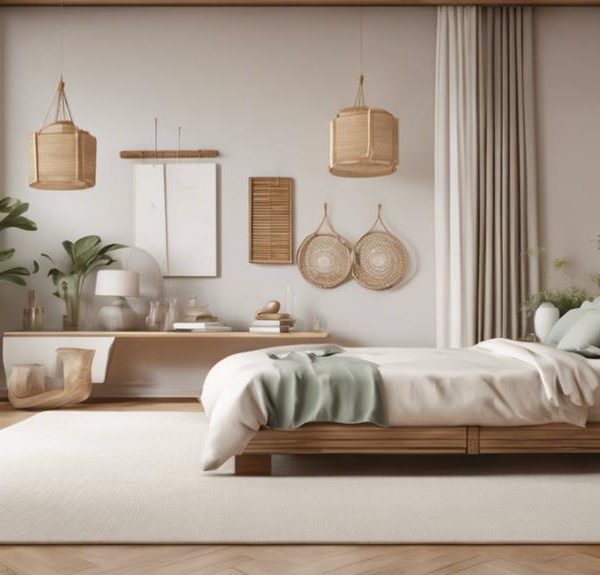
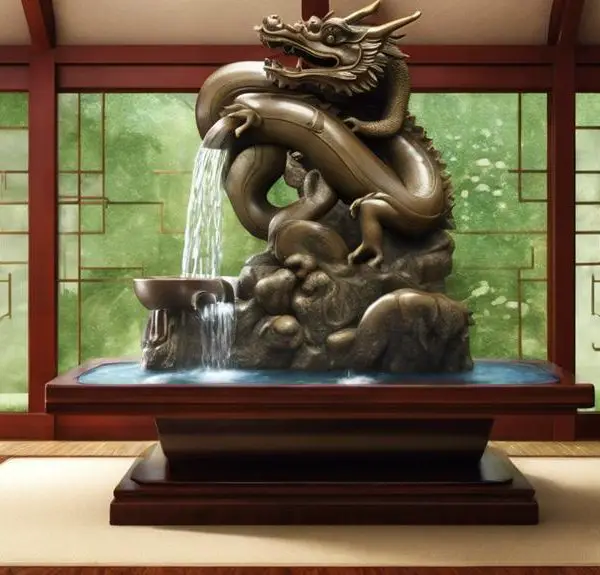
Sign up